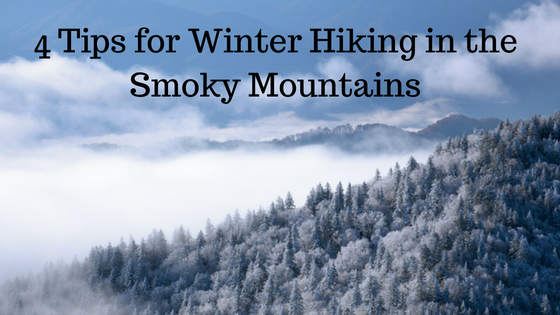Winter in the Smoky Mountains is a magical time with beautiful snow covered mountains, frozen waterfalls, and giant beautiful icicles. It is an experience that you don’t want to miss. Though winter hiking in the Smoky Mountains is a beautiful experience, it is still very important to be prepared for whatever Mother Nature throws your way. Here are some tips on how to prepare for winter hiking in the Smoky Mountains.
Smoky Mountains Road Closures
Each year, these roads shut down for a few months due to the winter season. During the winter months in the Great Smoky Mountains National Park, the weather gets icy and snowy, so it’s not safe to be driving on or hiking along these trails.
Balsam Mountain Road: Open May 22 – November 1
Cades Cove Loop Road: Closed Wednesday and Saturday mornings until 10 a.m. from May 6 through September 23. Otherwise, Cades Cove Loop Road is open daily.
Clingmans Dome Road: Open March 27 – November 30
Forge Creek Road: Open March 6 – December 31
Heintooga Ridge Road: Open May 22 – November 1
Little Greenbrier Road: Open April 10 – November 30
Parson Branch Road: Open April 10 – November 15
Rich Mountain Road: Open April 10 – November 15
Roaring Fork Motor Nature Trail: Open May 1 – November 30
Roundbottom/Straight Fork: Open April 3 – November 1
Best Times to Hike in the Smoky Mountains Winter Weather
When planning your first winter hike, be reasonable about the distance and difficulty of the trail. While it might be a cinch to do a twelve-mile loop in summertime conditions, you may run into ice or deep snow on the same trail during the winter. Also, many access roads to your favorite trailheads are closed and unplowed over the winter, which could add significant mileage to your trip. There is nothing quite as frustrating as wading through waist deep snow for miles on end, so choose a trail you know you can handle without difficulty.
Also, be prepared for some early mornings. Don’t forget that the sun sets much earlier in the winter months. Plan to be off the trail before dark to avoid getting lost or having an accident.
What to Pack for Hiking in the Winter
The secret to enjoying a winter hike when the temperature is in the single digits is dressing properly for the conditions. While your normal clothes are enough for a 15-minute stroll through a city park, for a long hike in frigid conditions, you’ll have a much better experience if you dress appropriately and stay dry.
There are a few basic items that every winter hiker should carry in case of emergency. Aside from basic hiking gear, you should always have a trail map, a first aid kit, a compass, a pocket knife or multi-tool, hand warming packets, and a headlamp. For a day hike, it’s a good idea to split up some of the heavier safety items among the members of your group.
Smoky Mountains Winter Weather Forecast
Winter is a fickle season in the Smokies. Days can be sunny with high temperatures of 65° Fahrenheit or snowy with highs in the 20s. In the lower elevations, snows of 1″ or more occur rather infrequently–usually only a few times each winter. Typically this snow melts within a few hours of falling.
At higher elevations, the climate is significantly cooler than in the surrounding lowlands and the mountain peaks receive much more snow.
Before visiting the park in winter, please call (865) 436-1200 for road closure and weather information. Dial extension 631 for updates on temporary road closures and extension 630 for a weather forecast.







